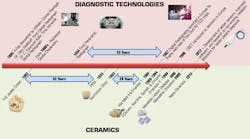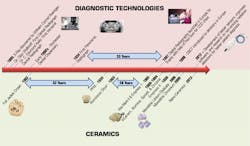by Andrew Koenigsberg, DDS, and Mason Kostinsky
Dentists are facing an unprecedented number of new "mission critical" clinical and practice-management technologies. These are technologies that must be incorporated for a practice to maintain its health and grow. Practices that do not move forward with these technologies will find themselves shrinking and losing value.
In addition, successful implementation of "mission critical" technologies demands solutions to psychological, financial, and human-resource challenges that will enable practices to compete as the dental technology revolution accelerates.
Fig. 1 – Timeline of Diagnostic and Ceramic Innovations
Life is Moving Faster
In the past, new technologies were sporadic and often took decades to gain traction. An example is the shift in crown material. PFMs were introduced in the mid-1950s. But it was not until the mid-1970s – 20 years later – that PFMs accounted for the majority of crowns made.
In contrast, after just two years, monolithic zirconia (which arguably is not as big an innovation) accounted for the majority of single-unit lab restorations at a major dental lab.
Figure 1 indicates that: (1) Historically (especially from 1930 to 2000), dentistry has been a relatively slowly evolving profession without a lot of "game-changing" innovations. (2) New technologies were slowly adopted. For most of the 20th century, a dentist could get away without updating office or technology for 20 years and not be left behind his or her peers. Some dentists could practice with the same equipment and techniques for their entire careers. (I bought a practice in Manhattan in 1982 that had the original X-ray unit and chair from 1933!)
In the past, companies have not spent significantly on research of new technologies. Because much dental care is paid for out-of-pocket and delivery is highly fragmented, neither the dentist nor patient was willing to pay for expensive technology. But the dental marketplace is changing with a decline in single practitioners and an increase in group and corporate entities.
These larger practices have the resources to invest in and share expensive technology. In just a few years, offices that have not incorporated digital management systems, digital radiography, optical scanning, and implant treatment, will be obsolete.
We can anticipate that current technologies will continue their rapid evolution, requiring updates or replacement. We can also expect new advances in imaging and diagnosis that will be "mission critical."
There are companies hard at work on soft-tissue imaging that will give us more information about the periodontal and pulpal health, as well as technology to evaluate cracks in teeth. These will surely be "mission critical" since they will significantly move forward the "art" of dentistry into a more scientific practice.
The concept of a static practice is quickly becoming obsolete as emerging technologies that elevate the level of patient care and enable a more productive practice are becoming more dominant in the dental market.
Facing the Technology Challenge
While there are many recommended steps for incorporating "mission critical" technologies, the three key factors to successful implementation are overcoming the psychological, financial, and human-resource challenges that new technologies place on the practice.
Psychological Adaptation to New Technology
As practicing dentists, struggling to keep skills and offices current, it is hard to see the larger trends in the industry. We have spent years hiring and training personnel, seeking helpful practice resources, nurturing partnerships, and developing systems that have a proven history. We do not relish the idea of modifying what seems to be working.
We can be in denial as to what is going on around us. Yet, we are all aware of industries and professions that have rapidly changed due to new technology and economic factors. Health-care delivery models – whether in medicine, pharmacology, or optometry – look nothing like they did 30 years ago when they were dominated by private practitioners. While many factors have contributed to these changes, technology is certainly among the leading causes.
Dentistry has been relatively immune to some of the factors that affected other areas of health care, especially related to reimbursement models and overhead, which have been stable in dentistry. But with major technological advances as a key contributor, dentistry is undergoing significant changes to which dentists must adapt.
In short, the dental technology revolution has created the broad challenge of structuring or re-inventing a practice model that can sustain the financial and human resources necessary to implement "mission critical" technologies.
Financial Resources
Technology has always been expensive to purchase, maintain, and upgrade. Traditionally, technology purchases involved a moderate up-front expense after which smaller as-needed repair and maintenance fees were charged by the distributor or manufacturer. Because the capabilities and complexity of technologies are increasing at an extraordinary rate, the cost of clinical and practice-management technologies is quickly climbing.
To respond to the increased expense, distributors created pricing models that enable practices to pay monthly fees for equipment, software support, hardware/software upgrades, and maintenance. Despite the monthly fee structure, the cost of multiple new technologies still is expensive, especially for the solo practitioner.
The solution to the overwhelming financial strain on the solo practitioner is scaling the cost across multiple providers. Nearly every piece of "mission critical" technology can be scaled across multiple providers. Once the use capacity is met, another unit could be purchased.
Digital radiography sensors are an example of a scalable, expensive, "mission critical" technology that should be upgraded over time. Most dentists never take into account an upgrade cost when purchasing a sensor.
In fact, most dentists who have chosen to implement digital radiography are still using their original sensors, which, in some cases, were purchased more than 10 years ago. While these sensors may still produce an image, the technology has advanced and can provide much better image quality, software interpretation, and – most importantly – better diagnostic capability.
Most solo practices have at least two sensors, which are rarely both in use at the same time. Being able to share the cost of sensors with an additional practicing dentist would cut the $20,000 to $30,000 cost of new sensors in half for each dentist.
When adding a third provider, another sensor may need to be purchased as two no longer adequately fit the demand needs of the practice. But even after purchasing a third sensor, the start-up, maintenance, and upgrade costs are still less expensive than the solo practice that owns two sensors.
While patients may not notice better care delivered as a result of upgrading a digital sensor, they definitely notice practice-management conveniences resulting from newer technologies.
Expensive services that enable an interactive web presence are "mission critical" as patients have come to expect the same web interaction they have with their credit cards, online shopping, and restaurant deliveries. The cost of implementing these online capabilities, like sensors, can also be scaled over multiple providers.
In the past, dental innovations had to be affordable to the solo practitioner in order to succeed. As the practice model shifts to larger groups and corporate practices, companies will develop products for these markets and small practices will find themselves unable to afford these new "solutions."
We are witnessing this phenomenon in the dental lab industry where hundreds of small and medium labs are closing at the expense of larger labs that can afford new technology and have the ability to incorporate it. The more technology costs can be scaled, the more affordable "mission critical" technologies become.
Specialized Human Resources
As practices begin adapting to the technology revolution by implementing "mission critical" technologies, dentists must realize the advanced level of training and skills that each technology requires. The practice must consider and deem a responsible party for each of the following:
- Daily operation
- Support
- Maintenance
- Training
- Integration of related technologies
Currently, with the exception of daily operators, many practices rely on outside sources to help with proper implementation. For example, a practice-management software provider may – for a monthly fee – provide online training, online support, phone support, upgrade services, and maintenance.
But as technologies become more complex and integrated into critical workflows, practices will be more productive by hiring a technology expert and trained staff that have specific knowledge of each technology, and how each technology works with associated technologies.
Consider a practice that uses practice-management software, a separate patient engagement tool, an interactive website and an external Internet marketing system. While administrators (daily operators) may understand the daily application and operations of each of these technologies, they simply don't have the technical expertise to quickly and efficiently solve issues and troubleshoot problems that may arise when using these technologies together.
Also, as new clinical technologies, such as CBCT and CAD/CAM, become more critical to daily patient care, clinical practice personnel must be trained and comfortable working these technologies. An internal technology expert will enable dentists and the clinical team to comfortably incorporate the technologies, knowing that if a problem occurs with clinical "mission critical" technologies, they have the appropriately trained personnel on hand to resolve the issue.
Of course, adding a technology expert and highly trained personnel to the dental team increases the implementation expense. Similar to scaling the purchase and maintenance costs of new technologies, human resources can also be shared among multiple providers.
The Technology Revolution Continues
Dentistry is undergoing a technology revolution. These technologies will continue to advance and will require adaptation by developing new practice models that enable "mission critical" technologies to remain affordable. Dentists that are not able to adapt to these changes will find it difficult to compete in this rapidly approaching environment.
Andrew Koenigsberg, DDS, completed prosthodontic residency in 1983. For the past 30 years, he has been in private practice in Manhattan, N.Y. In 2006, he and his partners opened Gallery57Dental, which incorporated a CAD/CAM ceramics lab. He cofounded CAD/CAM Excellence, an advanced education program for the dental community. Contact him at dr.k@gallery57dental.com. Since 2004, Mason Kostinsky has served as chief operating officer and director of marketing and business development at Gallery57Dental. In addition, he is president of Infinity Practice Development and cofounder of CAD/CAM Excellence. Contact him at mason@infinitypracticedevelopment.com.
Past DE Issues







